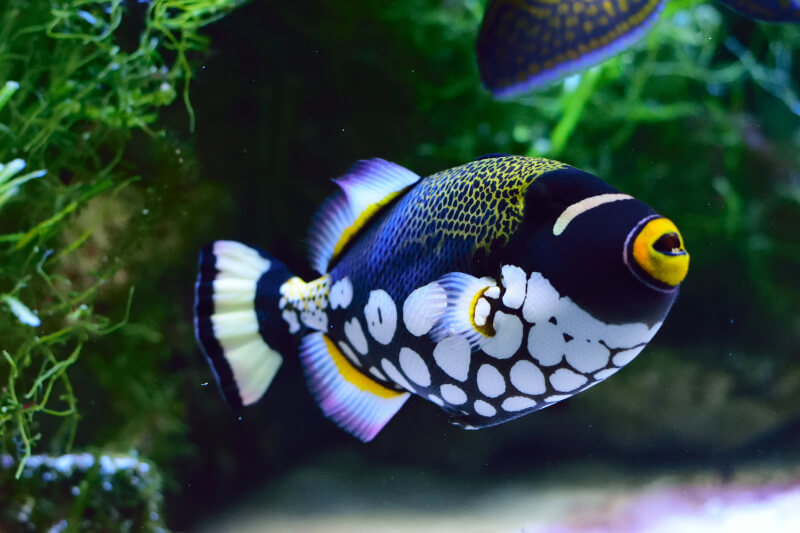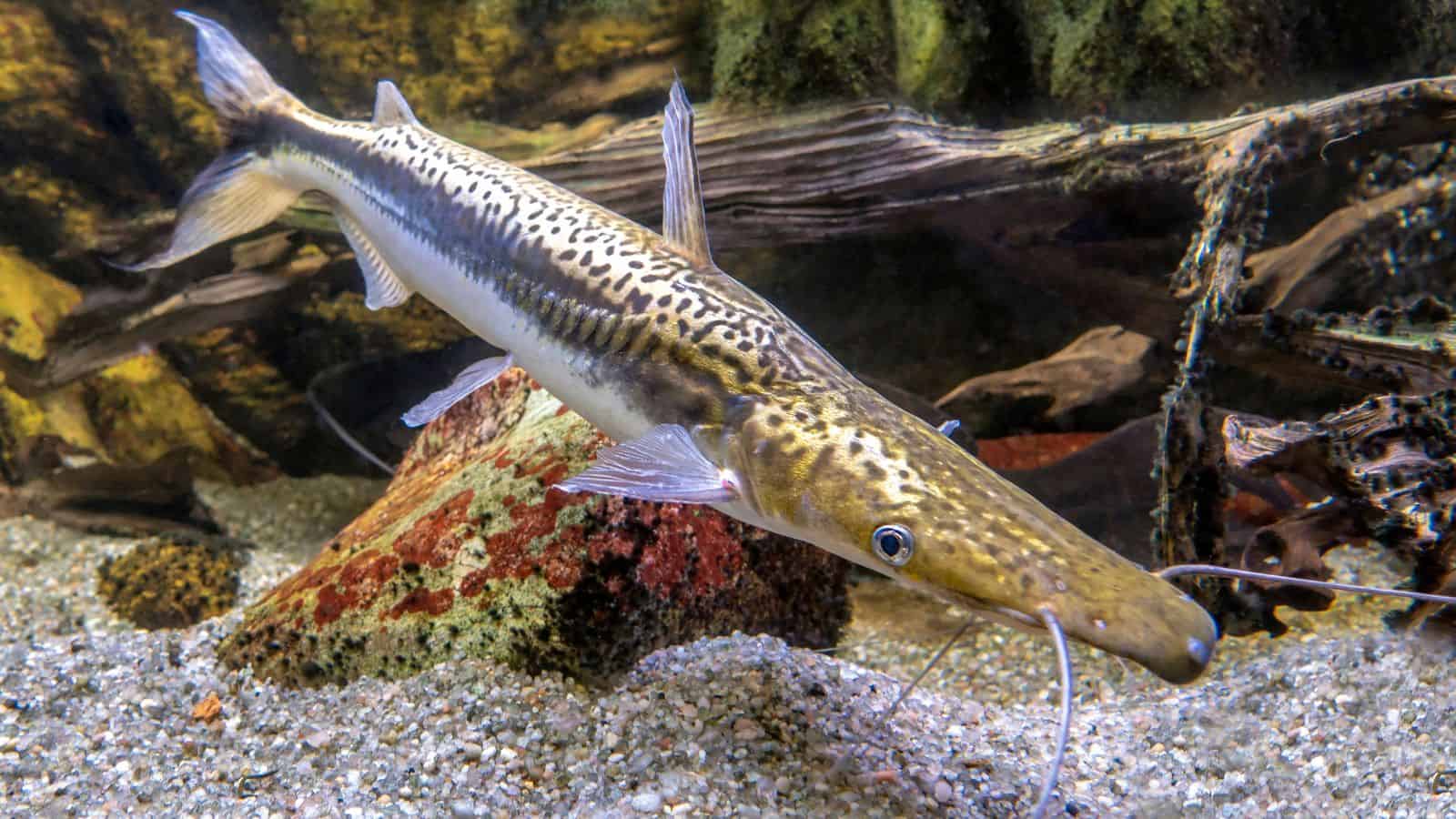Welcome to our care guide about Domino Damselfish which covers many details needed to succeed with these fish, except instructions on how to play dominoes (sorry).
We love the domino damsels not only because they are good looking but because they are quite hardy which is great for new aquarists.
We are excited to have you here and we hope to provide you with everything you need, so let’s get started!
Quick Facts 
| Scientific Name: | Dascyllus trimaculatus |
| Other Names / Common Species: | Threespot Dascyllus, Three Spot Damsel, Threespot Humbug, White Spot Puller, and Damsel Fish |
| Reef Safe: | Yes with caution |
| Lifespan: | 20yrs in captivity |
| Size: | 5 inches |
| Care: | Easy, it is a hardy fish |
| Diet: | Omnivore; flakes, pellets, frozen or live brine shrimp. |
| Water Parameters: | 72-82°F (22-28°C), 8.1-8.4pH, 8-12 dKH, 1.020-1.025 SG |
| Tank Size: | 55 gallons |
| Behavior: | Aggressive when adults |
| Breeding: | Difficult |
Appearance
The Domino Damselfish, also known by its scientific name, ‘Dascyllus trimaculatus‘, boasts an enigmatic presence in any marine aquarium.
At first glance, you’ll be captivated by their deep black bodies, which provide a stark contrast to their prominent white spots. These spots aren’t just for show; they serve a vital role in the wild, helping Domino Damsels blend with the light patterns filtered through the ocean’s surface.
Observing them in your tank, you’ll notice that each fish has a slightly different pattern, adding a unique touch to your aquatic collection.
If you look for Domino Damsels around the world, you will find them in the Indian and Pacific Oceans, East Africa, Red Sea, some areas of Japan and Australia. As far as depth, they are sometimes easy to find swimming just 3 feet or 0.9 meters from the surface but they can go as low as 180 feet.
Popular Species
The Domino Damselfish family showcases a variety of species, each with its charm.
Three Spot Domino Damselfish
The Three Spot Domino Damselfish is a marvel, with its three distinct white spots often representing the fish’s age. Younger fish display these spots vividly, which can fade as they mature.
Their resilience and adaptability to various marine environments make them a fascinating subject for both novice and expert aquarists.
Gold Domino Damselfish
On the rarer side, the Gold Domino Damselfish glimmers like a submerged treasure. If you’re lucky enough to come across one, it will quickly become the shining star of your saltwater habitat, commanding attention with its luminous hues.
Lifespan
When properly cared for, Domino Damselfish can have a lifespan in captivity up to 20 years whereas in the wild only 2 to 8 years. Their longevity in captivity heavily relies on the quality of their environment, which includes consistent water conditions, appropriate nutrition, and minimal stress.
With dedication and proper care, these fish can be a long-term commitment and a constant joy in your aquarium.
Average Size
Upon reaching adulthood, Domino Damselfish reach an average size of 5 inches in length, making them an ideal size for home aquariums.
This modest size ensures that they are prominent enough to be admired but do not require the expansive space that larger marine species demand.
Domino Damsel Care
These fish are known to be quite hardy so you should not have too much trouble caring for your damsel. This does mean it is invincible so make sure to provide the adequate care.
Tank Size
A 55-gallon tank is the minimum recommended size for a single Domino Damselfish, giving it enough room to swim and exhibit natural behaviors. If you intend to create a community or add tank mates, consider a larger tank to allow for adequate space and to maintain water quality.
Author Note: If you will be housing a pair with a male and a female aim for at least a 75 gallon tank.
Water Parameters
Mimicking the warm, tropical waters of the Indo-Pacific region is essential for the well-being of the Domino Damselfish. Here are the key water parameters you should maintain:
- Water temperature: 72-82°F (22-28°C)
- pH levels: 8.1-8.4
- Water hardness: 8-12 dKH
- Specific gravity: 1.020-1.025
Tank Setup
Creating an ideal environment for the Domino Damselfish goes beyond water chemistry; the physical setup of the tank is just as crucial. Happy Fish = Happy Aquarist 🙂
Begin with a layer of fine sand substrate, reminiscent of their natural ocean floor. Live rocks are a must—they not only offer places to hide and sleep but also serve as a natural filter and a surface for algae growth, a favorite snack of the Domino.
Author Note: When arranging these rocks, form stable structures and caves to satisfy their need for shelter. Providing enough spaces to hide will keep its slightly aggressive behavior under control.
Are Domino Damsel Reef Safe?
Yes, Domino Damsels are reef safe but with caution. Juveniles usually pose no threat to corals and are considered reef-compatible. However, as they mature, their territorial instincts kick in, and they may nip at soft corals and smaller invertebrates.
To keep a harmonious reef tank, it’s essential to monitor their behavior and consider compatible coral and invertebrate species that can hold their own against a feisty Damselfish.
Author Note: If possible try to introduce your domino damselfish when they are still young and even better if a larger fish already claimed the territory.
Common Possible Diseases & Prevention
Like all marine fish, Domino Damsels are susceptible to common saltwater diseases such as marine ich, velvet, uronema and bacterial infections. Prevention is the best medicine: maintaining pristine water conditions, a balanced diet, and proper tank mates reduces stress and illness.
Medicine sometimes helps but it can also affect other fish so try not to use it as the first response after your fish shows some signs of sickness. Many fish also bring lots of infections from previous aquariums so try to quarantine them for 6 to 8 weeks.
Author Note: Quarantining not only applies to new fish but also when treating a sick fish to make sure the disease does not spread.
Food & Diet
Domino Damselfish are omnivores with a penchant for both meaty foods and algae. In the wild, their diet consists of zooplankton, benthic algae, and small invertebrates.
In captivity, a mix of high-quality marine flakes, pellets, frozen or live brine shrimp, mysis shrimp, and spirulina will keep them healthy and vibrant. Feed small amounts two to three times a day for the best results.
Author Note: These damsels are aggressive feeders so make sure other fish eat too otherwise they will “mysteriously” start losing weight.
Behavior & Temperament
These damselfish are known for their bold and assertive demeanor. While small in size, the Dascyllus trimaculatus has no qualms about staking claim to a particular spot in the aquarium and defending it.
It’s crucial for aquarists to understand that while they are not aggressive without provocation, their territorial nature can lead to squabbles if space is tight or tank mates are too timid.
Domino Damsels tend to get grumpy as they age so bringing them young is the best option. Also try to first introduce non-aggressive species to reduce the possibility of conflicts otherwise the “Big Dogs” in the house won’t allow anyone to enter.

Domino Damsel Tank Mates & Predators
In choosing tank mates for your Domino Damselfish, aim for fish that match their bold personality and can respect boundaries. Good companions include:
Avoid overly passive fish like gobies (the Bumblebee Goby is cute but wouldn’t make it), dartfish like the Firefish Goby, assessors, fairy wrasses or those small enough to be considered prey.
As for predators, larger carnivorous fish pose a threat to Domino Damsels so avoid lionfish (the Dwarf Lionfish is aggressive but not too big), groupers and soapfish.
Breeding
Breeding Domino Damsels is a complex process that mirrors certain behaviors of clownfish, so we created the list below to make the information easier to digest.
- Understanding Gender: Know that Domino Damsels are born female and turn male with social ranking changes.
- Optimal Conditions: Maintain perfect water parameters and a spacious, predator-free tank. The ideal temperature for spawning should be kept between 79°F and 83°F (26°C to 28°C).
- Identifying a Pair: Recognize that sex determination by appearance is difficult, and finding a mated pair is key but challenging.
- Courtship Behavior: Observe the male’s “signal jumping” display and sound production to attract a mate, followed by the unique mating dance.
- Spawning: Watch for the spawning behavior, where both fish turn almost white, vibrate, and simultaneously release gametes, typically over a selected site like smooth rock.
- Egg Care: Post-spawning, the male will guard the over 1,000 eggs, oxygenating them and removing any undeveloped ones. This aggressive protection phase lasts until the eggs hatch in about 2 to 2.5 days.
- Larval Stage: Support the larval Damsels for 22 to 24 days post-hatching.
- Feeding the Fry: Feed the tiny fry with small foods like rotifers, specifically Brachionus Plicatilis, which require phytoplankton (Green Water) for sustenance.
- Continuous Care: Prepare for an intensive care period, as the Damsels can be extremely aggressive when protecting their young.
- Advanced Commitment: Approach breeding with careful planning and preparation, understanding that it is a demanding process best suited for experienced hobbyists or commercial breeders.
Conclusion
How was it? Very exciting, right? Caring for Domino Damselfish can bring both joy and a touch of complexity to your marine aquarium.
These beautiful fish will add a unique style to your aquarium by drawing the attention of friends and family with those unique dots. Even more, you can play dominoes and keep your damsel near to you for good luck!
For those looking to explore other fascinating species, consider delving into the captivating world of the Mandarin Goby as your next aquatic endeavor. If you will be showing off your Domino Damselfish on social media don’t forget to tag us on Facebook and if you have any questions don’t hesitate to reach out to us.



